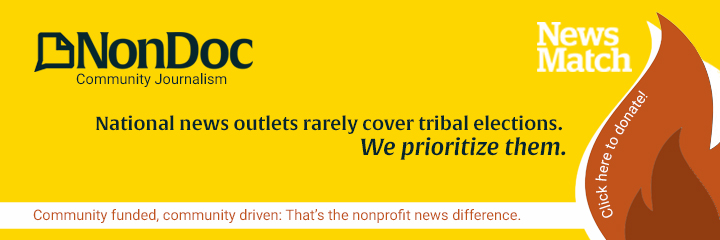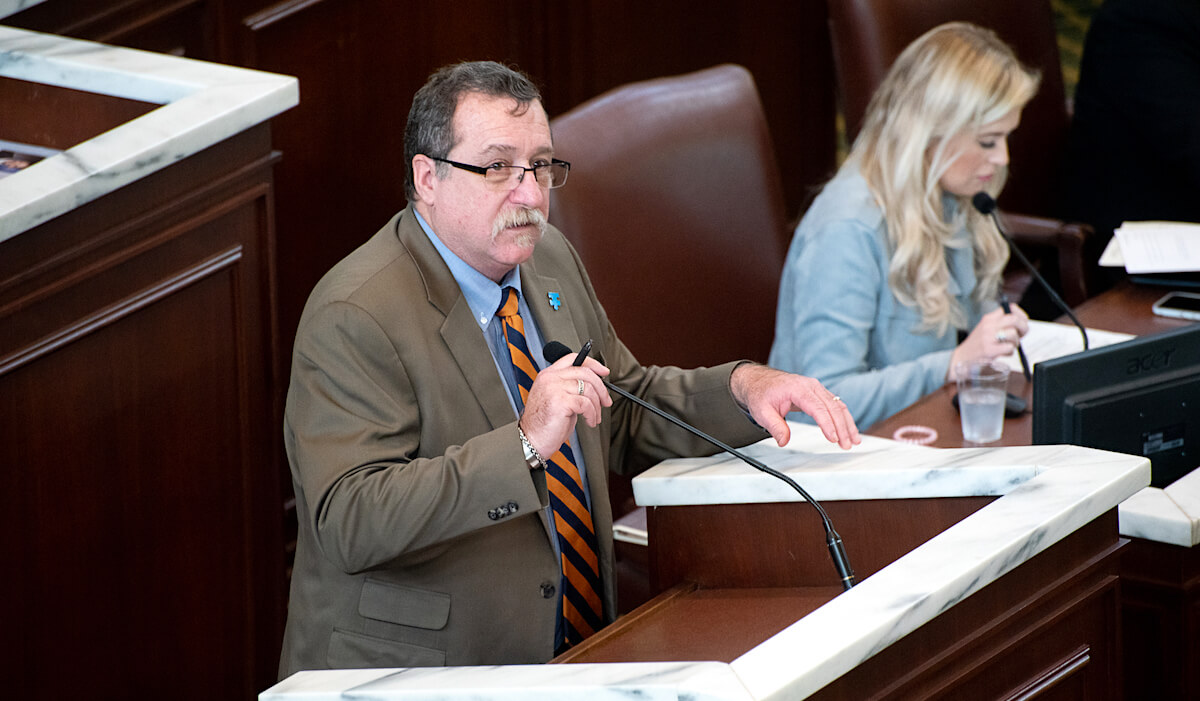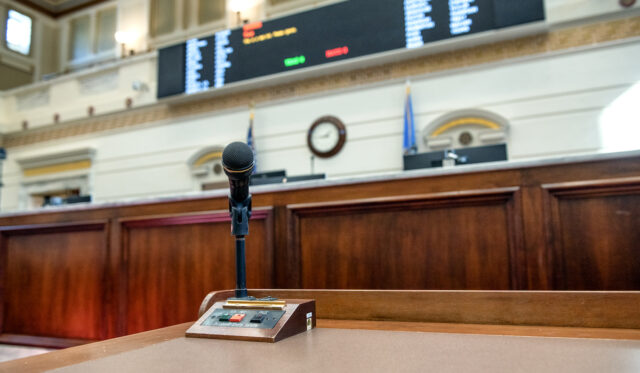
An hour before the House and Senate convened their Joint Committees on Appropriations and Budget to hear more than 30 bills, one of the committee chairmen passed by one of Gov. Kevin Stitt’s designated negotiators in the State Capitol rotunda. The budget negotiator called out, “Hey, you guys got a deal yet?”
While the question may have felt like a friendly joke, considering the Legislature was about to advance a full slate of appropriation bills, it also underscored lingering frustration from Stitt’s team regarding their limited involvement in this year’s budget negotiations.
Stitt’s team was only welcomed into budget negotiations a week ago, on Tuesday, May 10. Last year, by comparison, the governor’s team entered the room April 21, his staff said.
“This is abnormal for the governor’s team not to see the budget until this late in the process,” the state’s chief operating officer, Steven Harpe, told NonDoc on May 9. “I don’t think we’ll be that far off. They’ve been good partners in the past, so we’ll see.”
Stitt met with legislative leaders at the State Capitol until after midnight Tuesday, going through every line of the House and Senate budget agreement and discussing a few of Stitt’s requests that did not make it into the slate of bills filed around sundown.
“We had, I thought, a good meeting last night. We started it a little after 8:30, and we got out of here a little after midnight. We went line by line. He seemed to understand a lot of the numbers that he had questions about before,” Senate Appropriations and Budget Chairman Roger Thompson (R-Okemah) said. “I think it clarified some things for the governor. I thought we had a good meeting last night. I didn’t see it to be adversarial. There are probably some areas that he would like for us to continue a discussion on, and Sen. (Greg) Treat and Speaker (Charles) McCall may continue that with him.”
Stitt’s team did not return messages seeking comment on the budget Tuesday, but the governor’s lingering requests appear to include a 0.25 percent reduction in the state income tax, elimination of the state’s franchise tax and an additional $10 million for the Department of Commerce.
“He’s been clear on those,” Thompson said. “He’s still pushing for some things. At the same time, we listened to his State of the State (address). We know what his requests were. We had his requests before us. We’ve honored some of those requests. They’ve certainly been vetted through the subcommittee process, which is our responsibility to make sure that we’re funding those things that need to be funded. The governor met with the speaker and the pro tem last week. He asked for an additional $2 million to be added to the District Attorneys Council. So we did that based upon his request.”
‘A pretty conservative budget’
Although legislative leaders have agreed to put $698 million into the LEAD Act for contingent rebates for recruitment of the massive Project Ocean battery plant, other items of interest to the governor were yet to appear on JCAB agendas when Tuesday afternoon’s meetings began: an income tax cut, elimination of the franchise tax, money for the Department of Commerce’s continued recruitment of business ventures, and the reforms to charter school oversight passed by the House but thus far rejected by the Senate.
What legislative leaders have agreed upon is $9.84 billion in appropriations (embedded below), including:
- A 4.2 percent increase in funding for many state agencies, although some of those budgets reflect money designated for one-time investments and much of it dedicated to payroll;
- More than $32 million to eliminate the waiting list for developmentally disabled Oklahomans seeking a waiver to receive home-based services;
- $181 million for one-time rebates back to Oklahoma taxpayers at a rate of $75 for individuals filing as single and $150 for those filing as married. The rebates are set to be paid in December;
- $14 million to fund pay raises for Department of Public Safety employees such as state troopers;
- A 7.67 percent across-the-board pay raise for judges;
- Elimination of a 1.25 percent excise tax on the purchase of motor vehicles;
- $7 million for mental health provider rate increases and $2 million to increase access to acute behavioral health for children;
- $2.5 million for the Oklahoma State Bureau of Investigation to hire more agents to investigate cases in its backlog of internet child predator reports;
- One-time capital improvements for the Council of Law Enforcement Education and Training’s rehabilitation of its facilities;
- A 20 percent budget reduction for the Commissioners of the Land Office, which has been a subject of concern for some legislative leaders; and
- $250 million for a new Progressing Rural Economic Prosperity Fund aimed at helping communities around the state develop industrial parks and pursue other development opportunities.
Not included in the budget is a proposed elimination of the state portion of sales tax on groceries. That proposal had bipartisan support to begin the session, but it ultimately stalled out.
“It’s really a pretty conservative budget, and then we are not doing our full appropriating authority as we haven’t done in the last three sessions,” House Appropriations and Budget Chairman Kevin Wallace (R-Wellston) said. “You look at the rate of inflation, I would make the statement that agencies will probably be asked to do a lot more with less.”
Thompson agreed.
“I think it’s a great budget. I feel good because we are handling a lot of things that people need, from rural fire departments to victim’s compensation,” Thompson said. “The AG is getting extra money throughout this budget.”
Still, the Stitt administration’s limited engagement in the year’s state budget negotiations have fueled speculation that the governor may employ his veto pen to one extent or another.
DHS waiting list could be cleared within two years
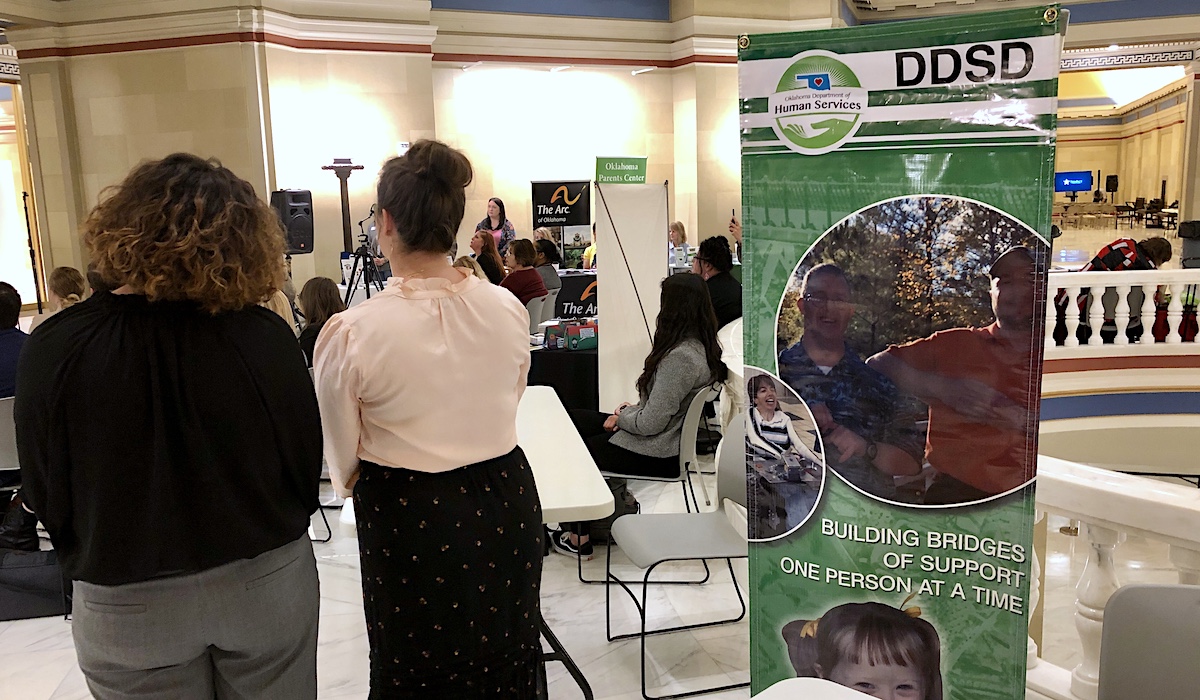
Last year, legislative leaders and administrators of the Department of Human Services pledged that a third-party review of the waiting list for home-based services to disabled Oklahomans would position the state to fund the elimination of that backlog with next year’s budget.
HB 4466 directs that $32.5 million of DHS appropriations be used to eliminate the waiting list for developmentally disabled adults. The bill also directs a 25 percent increase to reimbursement rates for service providers. (The agency is also directed to make other expenditures, including $1.1 million for an incentive for low-income families to purchase fresh fruits and vegetables.)
“It’s an opportunity for transformational investment in families in Oklahoma,” said Justin Brown, DHS director, after the House JCAB advanced HB 4466. “It’s been a multi-year effort to get to where we are at, and we are certainly thankful for the investment by the Legislature and the governor to address a dramatic need in the state of Oklahoma.”
As Sen. Paul Rosino (R-OKC) closed debate on the bill in the Senate JCAB meeting, he momentarily choked up, choosing his words carefully and alluding to his grandson with autism, whom he has referenced publicly before.
“This is very personal to me, as many of you know. To see this opportunity is a once-in-a-lifetime kind of event,” Rosino said. “I am very proud of this legislation, and I am very proud of this Legislature and what we have done.”
Thompson also praised the effort.
“Members, every year, there is one bill where you realize really why you are here. This is that bill,” Thompson said. “I think we will look back on this moment and this time and this day and say, ‘We did something good.'”
Brown said about 5,100 families are currently on the list waiting for home-based services. The backlog has meant families often wait more than a decade to be approved. Brown said that should change within 18 to 24 months, but growing the sector’s workforce will be critical, and the 25 percent rate increase is intended to help with that.
“You’re just about doubling the services. Right now, the workforce issues in our entire economy are critical for lots of industries, so our mechanism to help support the developmental disability space and building up the resources necessary is through the 25 percent rate increase,” Brown said. “We’ve been working with our providers to talk about utilizing those dollars to improve direct care incomes so that they can build the resources necessary to serve our communities.”
Lola Edwards, president of the Home and Community Based Services Council, praised the Legislature’s effort to address and eliminate the waiting list.
“For many years, critical service providers have struggled with low reimbursement rates which made it extremely difficult to hire and retain the dedicated employees who serve people recovering from injury or illness, or who require ongoing care,” Edwards said in a statement. “The 25 percent increase in reimbursement rates will help keep Oklahomans in their homes and, most importantly, it will allow thousands of people to receive the care they need.”
PREPping for statewide economic development
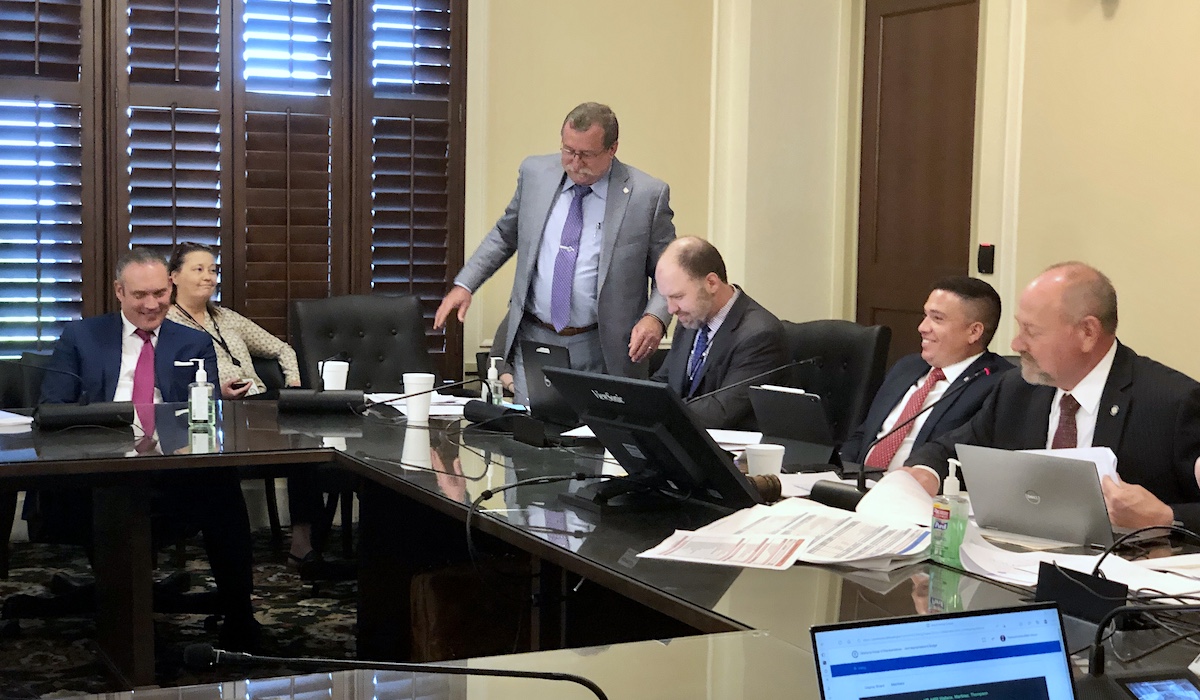
While lawmakers’ decision to deposit $698 million into the LEAD Fund in the hope that Project Ocean will reach shore this summer, a separate economic development program was revealed in Tuesday’s budget bills, but the guidelines and parameters are still being negotiated.
RELATED
As budget picture clears, new teacher scholarship incentive praised by Tres Savage
HB 4456 creates the Progressing Rural Economic Prosperity Fund and HB 4464 appropriates $250 million to the fund, but neither bill specifies how the money will be used.
House Speaker Pro Tempore Kyle Hilbert (R-Depew) presented the bills in House JCAB and said the PREP program’s goal is to enable future economic development opportunities across the state. Currently, most major announcements in recent years have been located at the MidAmerica Industrial Park because it offers a “shovel-ready” opportunity for development.
“It’s important that we invest in the rest of the state,” Hilbert said. “This fund does not set up a mechanism for how that is distributed. We’re still working with the good folks across the rotunda on what exactly the mechanism will look like.”
Rep. Cyndi Munson (D-OKC) asked for more guardrails in and details about the PREP program.
“Some of the things that I feel like are important — and this is still getting worked out — is when you look at our industrial parks and airports and rail projects and making sure that they are ready,” Hilbert replied. “There are a lot of other great sites across the state, but they may not have the big five: water, sewer, broadband, electric and gas.”
Prior to Tuesday’s meeting, Wallace described the program in his own words, noting that it could support industrial parks, airports, industrial waterways, railways and even hospital development in rural areas.
“We’d really like to see the state prosper but across the state and not just one area,” Wallace said. “There is definitely a concept and a really well-thought-out plan, but we still don’t have 100 percent agreement between the two chambers. But we’ll get there before the end of this session.”
Wallace said the program will not be a rebate or a tax credit, but rather “matching grants.” Whether it will run through the Department of Commerce or another entities and what percentage of investment qualifies for the match are key remaining questions.
“We’ve had a lot of conversations, and all of those ideas are out there,” Wallace said. “There’s bits and pieces we seem to have in agreement between the two chambers, yet there is no final agreement. It’s not going to be the first dollar in. It’s to complete something to be shovel-ready.”
Wallace said the PREP program could work hand-in-hand with some projects being considered for funding from the American Rescue Plan Act.
“That’s what has made MidAmerica so attractive over the years. Everything is there other than just a little seed money,” Wallace said. “So we want to incentivize to complete industrial parks or if they’re needing, for instance — hey, we could attract this business here, but we need a gas line.”
“There is a conceptual map,” Wallace said. “I don’t want to get my head over my skis, but there is a map out there that shows, when you look at the map, it’s like, ‘Holy mackerel, it’s the entire state. Every county.'”
Summary of Fiscal year 2023 appropriations
Other state budget bills advanced
Other budget bills advanced in House and Senate JCAB meetings Tuesday include:
- SB 1040 is the general appropriations bill that directs funding to state agencies. The bill advanced from the House JCAB 22-6;
- HB 4454 appropriates $698 million into the LEAD Fund for large-scale economic development rebates, as specifically outlined in the state’s pursuit of “Project Ocean“;
- HB 4460 would increase the bonding capacity of the Grand River Dam Authority from $1.4 billion to $2 billion if “Project Ocean” occurs within the state. A public power utility, the GRDA has sought to increase its bonding capacity for years.
- HB 4449 exempts the Military Department from a requirement that 1.5 percent of money spent on a capital project be sent to the Oklahoma Arts Council for art in public places;
- HB 4457 creates a nine-member Oklahoma Route 66 Commission and an associated revolving fund. The bill also modifies apportionment percentages of state sales tax receipts and dedicates up to $6.6 million annually to the Route 66 Commission;
- HB 4458 removes the Department of Environmental Quality from the list of agencies to locate at the Oklahoma Commons building and removes the requirement for DEQ to sell its building on Robinson Avenue in Oklahoma City;
- HB 4459 gradually increases from $120 million to $150 million the amount of money placed in the County Improvements for Roads and Bridges Fund by Fiscal Year 2018;
- HB 4465 establishes expenditure requirements for the State Department of Education;
- HB 4467 establishes expenditure requirements for the Department of Commerce;
- HB 4468 establishes expenditure requirements for the Oklahoma Center for Advancement of Science and Technology;
- HB 4469 directs the Oklahoma Historical Society to spend $65,000 on a theatrical production associated with the Smithsonian;
- HB 4470 directs more than $14 million to be used by the Department of Public Safety to increase pay for state troopers and other employees. The bill also directs $150,000 to be used for the creation and maintenance of the new Mental Wellness Division of the department;
- HB 4471 requires the Department of Public Safety to submit a report annually by Dec. 1 detailing the results of Highway Patrol Trooper Academies;
- HB 4472 establishes expenditure requirements for the Attorney General’s Office, including pay increases for certain employees and increased funding for human trafficking enforcement and victim services;
- HB 4473 directs more than $181 million to the Inflation Relief Stimulus Fund;
- HB 4474 specifies use of funds from the Inflation Relief Stimulus Fund to include one-time direct payments of $75 to Oklahoma taxpayers filing as single and $150 to taxpayers filing as married;
- HB 2958 directs $5.3 million to help fund technology and other efforts related to combating human trafficking;
- HB 2959 directs the Oklahoma Water Resources Board to allocate $3 million to the Emergency Drought Relief Fund;
- SB 1043 establishes expenditure requirements for the Department of Health, including $2.5 million for targeted salary adjustments and $100,000 for increased outreach regarding sickle cell anemia;
- SB 1048 establishes expenditure requirements for the Department of Mental Health and Substance Abuse Services, including $7 million for targeted provider rate increases and $2 million to increase services for children with acute behavioral health issues;
- SB 1052 directs the Oklahoma Department of Corrections to dedicate $4.89 million to the privately operated Lawton Correctional and Rehabilitation Facility for a per diem increase. It also directs $2.92 million to the privately operated Davis Correctional Facility for the same purpose;
- SB 1055 establishes expenditure requirements for the Oklahoma Office of Juvenile Affairs;
- SB 1056 appropriates $5.3 million to the Oklahoma Bureau of Narcotics and Dangerous Drugs for the purpose of supporting “marijuana enforcement teams”;
- SB 1058 directs $4 million from the Department of Agriculture, Food and Forestry to be sent to the Oklahoma State University College of Veterinary Medicine and $1.5 million to the college’s animal disease diagnostic laboratory. The bill makes other appropriation requirements from ODAFF to other entities;
- SB 1060 authorizes pay raises for employees of the Department of Tourism and Recreation, including CLEET-certified officers;
- SB 1061 establishes expenditure requirements for the Office of Management and Enterprise Services;
- SB 1074 establishes expenditure requirements for the Oklahoma Health Care Authority, including the creation of an enhanced payment for intermediate care facilities;
- SB 1075 eliminates a 1.25 percent excise tax on the purchase of motor vehicles, which had been created by the Legislature in 2018;
- SB 1079 allows certain companies to qualify for the Manufacturing Tax Credit based on 2021 payroll;
- SB 1091 creates a February 2021 Winter Storm Grant Revolving Fund and directs the Oklahoma Department of Agriculture, Food and Forestry to create a grant program for municipalities that have incurred high utility costs.

